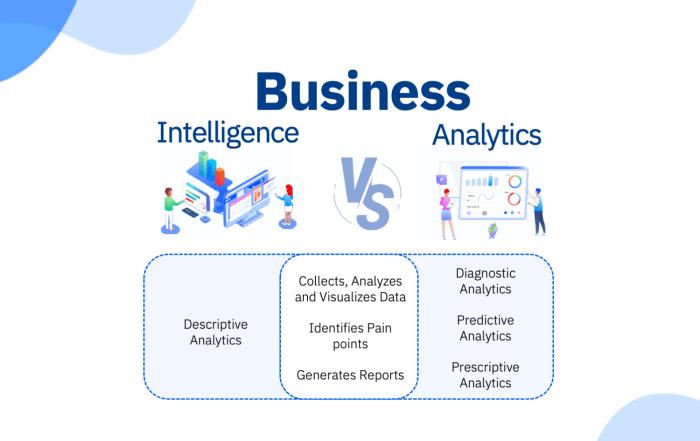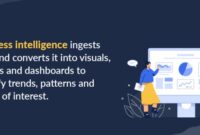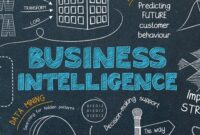In the realm of data-driven decision-making, data analytics and business intelligence (BI) emerge as indispensable tools, transforming businesses with their ability to extract meaningful insights from vast amounts of data. From optimizing operations to predicting future trends, data analytics and BI empower organizations to make informed choices and achieve unprecedented growth.
Data analytics and business intelligence are crucial for businesses seeking to gain insights from their data. Professionals seeking to enhance their skills in this field can consider a business intelligence master program to develop their expertise in data analysis, visualization, and strategic decision-making.
This investment in knowledge and skills can empower professionals to drive data-driven decision-making within their organizations, unlocking the full potential of data analytics and business intelligence.
As we delve into the intricacies of data analytics and BI, we’ll uncover the methods of collecting, preparing, and analyzing data, explore the power of data visualization, and examine real-world applications of BI in driving business success.
Furthermore, we’ll address the ethical and legal considerations surrounding data usage, ensuring responsible and compliant practices.
Data Analytics and Business Intelligence (BI) Overview
Data analytics and business intelligence (BI) are powerful tools that can help businesses make better decisions. Data analytics involves collecting, cleaning, and analyzing data to extract meaningful insights. BI is the process of using these insights to make informed decisions.
Businesses use data analytics and BI to improve their operations in a variety of ways. For example, they can use data analytics to identify trends in customer behavior, optimize marketing campaigns, and improve product development.
BI can be used to create dashboards and reports that provide managers with a real-time view of their business.
Data analytics and business intelligence are closely intertwined, with the latter providing a comprehensive understanding of business data to drive informed decision-making.
Business intelligence, as defined , involves the gathering, analysis, and presentation of data to provide insights into business performance and opportunities.
This information is crucial for data analytics, as it helps identify patterns, trends, and correlations within the data, enabling businesses to optimize their operations and achieve their goals.
Data Collection and Preparation

The first step in data analytics is to collect data from a variety of sources. This data can come from internal sources, such as customer relationship management (CRM) systems and enterprise resource planning (ERP) systems. It can also come from external sources, such as social media data and market research reports.
Once the data has been collected, it needs to be cleaned and prepared for analysis. This involves removing duplicate data, correcting errors, and transforming the data into a format that can be analyzed by data analytics tools.
Data integration is the process of combining data from multiple sources into a single, unified view. This can be a complex process, but it is essential for businesses that want to get a complete picture of their operations.
Data Analysis and Visualization, Data analytics and business intelligence
There are a variety of data analysis techniques that can be used to extract meaningful insights from data. These techniques include:
- Descriptive statistics: These statistics describe the basic characteristics of a dataset, such as the mean, median, and mode.
- Inferential statistics: These statistics allow us to make inferences about a population based on a sample.
- Machine learning: Machine learning algorithms can be used to identify patterns in data and make predictions.
Data visualization is the process of presenting data in a way that makes it easy to understand. Data visualization tools can be used to create charts, graphs, and other visual representations of data.
Business Intelligence Applications
BI can be used to improve decision-making processes in a variety of ways. For example, BI can be used to:
- Identify trends and patterns in data
- Forecast future events
- Optimize business processes
- Make better decisions about marketing, product development, and other business strategies
There are many case studies of businesses that have successfully implemented BI solutions. For example, Walmart uses BI to track customer behavior and optimize its marketing campaigns. Amazon uses BI to personalize the shopping experience for its customers.
Data analytics and business intelligence are essential for businesses looking to make informed decisions. One of the most important tools in a business intelligence toolkit is the dashboard.
A dashboard provides a visual representation of key data, making it easy to track progress and identify trends.
For more information on dashboards in business intelligence, visit this article. Data analytics and business intelligence can help businesses improve their operations, increase efficiency, and gain a competitive advantage.
BI can drive business growth and efficiency in a variety of ways. For example, BI can help businesses to:
- Increase sales and profits
- Reduce costs
- Improve customer satisfaction
- Make better decisions
Data Security and Privacy

There are a number of potential risks associated with data analytics and BI. These risks include:
- Data breaches
- Data misuse
- Privacy violations
Businesses need to take steps to protect their data from these risks. These steps include:
- Implementing strong data security measures
- Educating employees about data security and privacy
- Developing a data governance policy
Businesses also need to be aware of the legal and ethical considerations surrounding data usage. For example, businesses need to comply with privacy laws and regulations.
Last Point
Data analytics and BI are not mere buzzwords; they are transformative forces shaping the business landscape. By embracing these technologies, organizations can unlock the potential of their data, gain a competitive edge, and position themselves for success in the data-driven era.
FAQ Summary: Data Analytics And Business Intelligence
What is the difference between data analytics and business intelligence?
Data analytics involves the exploration and analysis of data to uncover patterns and trends, while business intelligence focuses on using these insights to make informed business decisions.
How can data analytics help my business?
Data analytics can help businesses improve customer segmentation, optimize marketing campaigns, identify operational inefficiencies, and predict future demand.
What are some common data analytics techniques?
Common data analytics techniques include descriptive statistics, regression analysis, machine learning, and data mining.
How can I ensure the security of my data?
Implement strong data encryption, access controls, and regular security audits to protect your data from unauthorized access and breaches.




